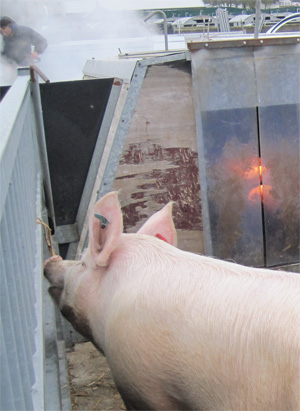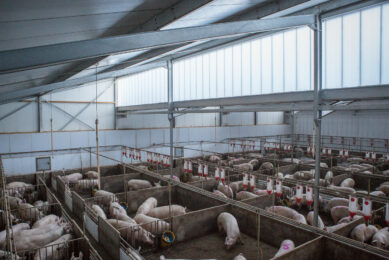Going for performance and high welfare

Often, the goals sound contradictory: Aiming for high performance is usually not associated with care for animal welfare. But is it impossible? Bishop Burton College’s pig unit in the UK shows that the two may well go together.
Bishop Burton College’s 220 sow pig unit based in Yorkshire, UK, is impressive in the way they are pursuing good performance, while trying to adopt high welfare standards. In the UK, high welfare production according to Freedom Foods standards carries a 5% premium per kg deadweight produced, which helps to contribute to the unit’s profitability.
This year they also received an award from Compassion in World Farming for their high welfare system of production. In addition, the use of high health replacement stock from JSR Genetics, which are enzootic pneumonia (Myco-plasma hyopneumoniae) and swine dysentery (Brachyspira hyodysenteriae) free, help to optimise production and minimise medication and antimicrobial use. The overall herd health is supervised by Mark Howells, principle of Howells Veterinary Services.The pig unit is part of the College’s educational programme and offers practical and theoretical expertise to help a range of students from young, 16 year olds on modern apprenticeships or day release, to full time Diploma and even Degree level students.
Up to 120 students can pass through the pig unit per week, which brings with it concerns about biosecurity. However, they are provided with suitable changing facilities and the unit’s own overalls and boots to ensure foreign diseases are excluded. Biosecurity is taken very seriously on the unit and direct access is excluded for feed lorries and vehicles taking the animals to slaughter.As well as lecturing three days a week, the unit manager Gavin Hodgson also makes time to run clinical and production trials, with a facility of 14 pens providing up to seven replicates for statistical purposes. This helps them to maintain the unit’s cutting-edge production wise, as well as enabling students to get involved with suitable project work. They have recently carried out a study comparing Tylan and Denagard premixes for the control of ileitis, with both products showing comparable success and are evaluating Profert to improve fertility in the sows.
Breeding side
To comply with Freedom Foods standards, sows must be free to move around five days after they have farrowed. This requires different housing from the normal farrowing-crate system. Over 40% of sows are kept outside in paddocks in the UK and this has led to the development of the farrowing-arc system. It is comparatively cheap housing in comparison with a regular farrowing house on a sow-place basis but does have its own restrictions. As the system has worked well on the land, a number of farms have brought this system on to concrete to improve access, while controlling cost.
Dry sows are kept in groups of six, or seven if gilts. They are vaccinated for the common infections such as Parvovirus, Erysipelas, PRRS virus and recently Escherichia coli. The sows are then moved into individual arcs on a two-week batch farrowing system.The arcs are straw based for insulation and to enable the sow to express her nesting behaviour but due to a very severe winter last year and a relatively high piglet loss during the first three days of life (see box), they have installed heat lamps in a creep area to keep the piglets warm and have a safer zone to lie in, as well as offering a snug environment for both sow and her piglets. The effects on piglet mortality are to be evaluated. The piglets have their teeth clipped and receive iron injections but tails are not docked and males are not castrated.Weaning is at 28 days and the sows are kept in batches in the service house. Heat onset is sometimes delayed and coordinated with the use of Regumate and then they are exposed to boars to stimulate heat and then mainly served with AI. Attention to good hygiene is also considered important between batches.
Growing pigs
The pigs are weaned into straw yards and split sexed. The creep feed is supplied by SCA Nutrition and contains zinc oxide at high doses (3,500 ppm) to control any post-weaning diarrhoea. The rest of the feed is supplied by a local mill, Thompsons of York. Generally, there are few problems at weaning, as the pigs can bury themselves into the straw to keep warm. The pigs are only vaccinated to prevent PCV2 infections. There is no recorded Streptococcus suis (meningitis) or Glässer’s disease (Haemophilus parasuis) so antibiotics are rarely used. The pigs are moved after six weeks to second stage housing also straw yards, where they stay in their respective groups for a further four weeks (week 15) before they are moved into their final finishing pens.
Because of the absence of enzootic pneumonia, swine dysentery and also no recorded Actinobacillus pleuropneumoniae and pleurisy, the pigs grow remarkably well. As long as stocking density is controlled, tail biting is not an issue. Mortality from weaning to slaughter at approximately 103 kg liveweight is below average at 4.3% (BPEX average 5.6%). Low grade ileitis (Lawsonia intracellularis) has been a problem especially in the second stage pigs and antibiotics are used there but usually in the finishing stages the pigs recover and fly on. Growth rate from weaning to slaughter is exceptional at 799 g/day (BPEX average 655 g/day) and feed conversion efficiency (FCE) is 2.57 (BPEX average 2.41), which is slightly higher than average.Overall, the system is not yet perfect, improvements to the farrowing area and reducing piglet mortality are key targets.
The farrowing arcs are needed for freedom farrowing at this stage but on a longer term a farrowing house system may be required to really improve live pig survival. Genetically, the production of good numbers of live pigs born and their performance through the straw-based yard system is exceptional, delivering well above average growth performance and good FCE. The high health status contributes to this and also keeps the growing pig mortality below average. A combination of high health and high welfare can result in highly profitable and effective pig production.











